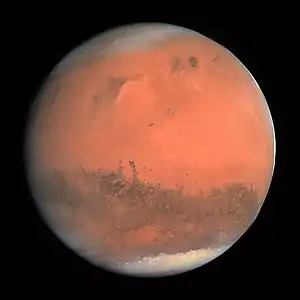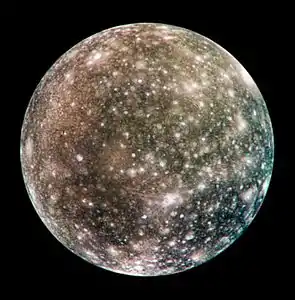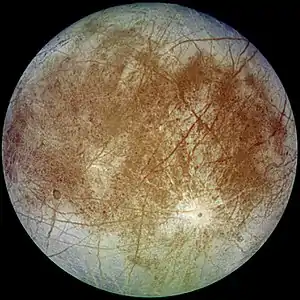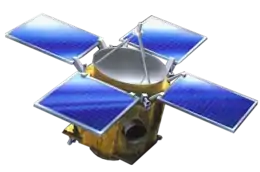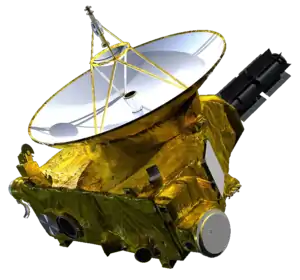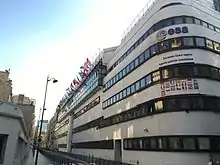Jupiter Icy Moons Explorer
The JUpiter ICy moons Explorer (JUICE) is an interplanetary spacecraft in development by the European Space Agency (ESA) with Airbus Defence and Space as the main contractor. The mission will study three of Jupiter's Galilean moons: Ganymede, Callisto, and Europa (excluding the more volcanically active Io) all of which are thought to have significant bodies of liquid water beneath their surfaces, making them potentially habitable environments.[6]
 Artist's impression of the JUICE spacecraft | |||||||||||||||||||||||||
| Mission type | Planetary science | ||||||||||||||||||||||||
|---|---|---|---|---|---|---|---|---|---|---|---|---|---|---|---|---|---|---|---|---|---|---|---|---|---|
| Operator | ESA | ||||||||||||||||||||||||
| Mission duration | Cruise phase: 7.6 years Science phase: 3.5 years | ||||||||||||||||||||||||
| Spacecraft properties | |||||||||||||||||||||||||
| Manufacturer | Airbus Defence and Space | ||||||||||||||||||||||||
| Launch mass | 4,800 kilograms (10,600 lb)[1] | ||||||||||||||||||||||||
| Dry mass | 1,900 kilograms (4,200 lb)[1] | ||||||||||||||||||||||||
| Power | 820 watts[2] from a Solar array ~100 square metres (1,100 sq ft)[3] | ||||||||||||||||||||||||
| Start of mission | |||||||||||||||||||||||||
| Launch date | June 9, 2022 (launch window: May 21 to June 17 2022)[4][5] | ||||||||||||||||||||||||
| Rocket | Ariane 5[4] | ||||||||||||||||||||||||
| Launch site | Centre Spatial Guyanais, ELA-3 | ||||||||||||||||||||||||
| Contractor | Arianespace | ||||||||||||||||||||||||
| Flyby of Earth | |||||||||||||||||||||||||
| Closest approach | May 2023 | ||||||||||||||||||||||||
| Distance | 12,700 kilometres (7,900 mi) | ||||||||||||||||||||||||
| Flyby of Venus | |||||||||||||||||||||||||
| Closest approach | October 2023 | ||||||||||||||||||||||||
| Distance | 9,500 kilometres (5,900 mi) | ||||||||||||||||||||||||
| Flyby of Earth | |||||||||||||||||||||||||
| Closest approach | September 2024 | ||||||||||||||||||||||||
| Distance | 1,950 kilometres (1,210 mi) | ||||||||||||||||||||||||
| Flyby of Mars | |||||||||||||||||||||||||
| Closest approach | February 2025 | ||||||||||||||||||||||||
| Distance | 1,100 kilometres (680 mi) | ||||||||||||||||||||||||
| Flyby of Earth | |||||||||||||||||||||||||
| Closest approach | November 2026 | ||||||||||||||||||||||||
| Distance | 3,700 kilometres (2,300 mi) | ||||||||||||||||||||||||
| Jupiter orbiter | |||||||||||||||||||||||||
| Orbital insertion | October 2029 (planned) | ||||||||||||||||||||||||
| Orbital departure | September 2032 | ||||||||||||||||||||||||
| Ganymede orbiter | |||||||||||||||||||||||||
| Orbital insertion | September 2032 (planned) | ||||||||||||||||||||||||
| |||||||||||||||||||||||||
 JUICE mission insignia | |||||||||||||||||||||||||
The spacecraft is set for launch in June 2022 and will reach Jupiter in October 2029 after five gravity assists and 88 months of travel. By September 2032, the spacecraft will enter orbit around Ganymede for its close up science mission, becoming the first spacecraft to orbit a moon other than the moon of Earth. The selection of this mission for the L1 launch slot of ESA's Cosmic Vision science programme was announced on 2 May 2012.[7] Its period of operations will overlap with NASA's Europa Clipper mission, launching in 2024.
History

The mission started as a reformulation of the Jupiter Ganymede Orbiter proposal, which was to be ESA's component of the cancelled Europa Jupiter System Mission – Laplace (EJSM-Laplace).[8] It became a candidate for the first L-class mission (L1) of the ESA Cosmic Vision Programme, and its selection was announced on 2 May 2012.[7]
In April 2012, JUICE was recommended over the proposed ATHENA X-ray telescope and a gravitational wave observatory (New Gravitational wave Observatory (NGO)).[9][10] In July 2015, Airbus Defence and Space was selected as the prime contractor to design and build the probe, to be assembled in Toulouse, France.[11]
Timeline
Launch and trajectory
JUICE will be launched in June 2022 by an Ariane 6 rocket. Following the launch, there is a planned first flyby of Earth in May 2023, Venus in October 2023, second flyby of Earth in September 2024, Mars in February 2025 and a final third flyby of Earth in November 2026, to put the JUICE on a trajectory to Jupiter.
Arrival to the Jovian system
In October 2029, when it arrives in Jupiter's system, JUICE will first perform a flyby of Ganymede in preparation for orbital insertion ≈7.5 hours later. The first orbit will be elongated, with the first Jupiter closest approach taking place in May 2030. After that, the orbits will be gradually closer to Jupiter, resulting in a circular orbit.
The first Europa flyby will take place in October 2030. JUICE will enter a high inclination orbit to allow exploration of Jupiter's polar regions. JUICE will study Jupiter's magnetosphere. Then, a Callisto flyby in April 2031 will put JUICE on a normal equatorial orbit. Additionally, a transit of Europa and Io will occur on 27 January 2032.
Orbital insertion on Ganymede
In September 2032, JUICE will enter an elliptical orbit around Ganymede, becoming the first spacecraft to orbit a moon other than Earth's moon. The first orbit will be at a distance of 5,000 kilometres (3,100 mi). In February 2033, JUICE will enter a circular orbit 500 kilometres (310 mi) above the surface of Ganymede. JUICE will study Ganymede's composition and magnetosphere among other things.
Planned deorbit on Ganymede
When the spacecraft consumes its propellant, JUICE is planned to be deorbited and impact Ganymede in February 2034.[12]
Science objectives
.jpg.webp)

The Jupiter Icy moons Explorer orbiter will perform detailed investigations on Ganymede and evaluate its potential to support life. Investigations of Europa and Callisto will complete a comparative picture of these Galilean moons.[13] The three moons are thought to harbour internal liquid water oceans, and so are central to understanding the habitability of icy worlds.
The main science objectives for Ganymede, and to a lesser extent for Callisto, are:[13]
- Characterisation of the ocean layers and detection of putative subsurface water reservoirs.
- Topographical, geological and compositional mapping of the surface.
- Study of the physical properties of the icy crusts.
- Characterisation of the internal mass distribution, dynamics and evolution of the interiors.
- Investigation of Ganymede's tenuous atmosphere.
- Study of Ganymede's intrinsic magnetic field and its interactions with the Jovian magnetosphere.
For Europa, the focus is on the chemistry essential to life, including organic molecules, and on understanding the formation of surface features and the composition of the non-water-ice material. Furthermore, JUICE will provide the first subsurface sounding of the moon, including the first determination of the minimal thickness of the icy crust over the most recently active regions.
More distant spatially resolved observations will also be carried out for several minor irregular satellites and the volcanically active moon Io.
Spacecraft
Design drivers
The main spacecraft design drivers are related to the large distance to the Sun, the use of solar power, and Jupiter's harsh radiation environment. The orbit insertions at Jupiter and Ganymede and the large number of flyby manoeuvres (more than 25 gravity assists, and two Europa flybys) requires the spacecraft to carry about 3,000 kilograms (6,600 lb) of chemical propellant.[14]
Gravity assists include:[1]
- Interplanetary transfer (Earth, Venus, Earth, Mars, Earth)
- Jupiter orbit insertion and apocentre reduction with multiple Ganymede gravity assists
- Reduction of velocity with Ganymede–Callisto assists
- Increase inclination with 10–12 Callisto gravity assists
Science instruments
On 21 February 2013, after a competition, 11 science instruments were selected by ESA, which are being developed by science and engineering teams from all over Europe, with participation from the US.[15][16][17][18]
Japan will also contribute several components for SWI, RPWI, GALA, PEP, JANUS and J-MAG instruments, and will facilitate testing.[19][20][21]
Jovis, Amorum ac Natorum Undique Scrutator (JANUS)
A camera system to image Ganymede and interesting parts of the surface of Callisto at better than 400 m/pixel (resolution limited by mission data volume). Selected targets will be investigated in high-resolution with a spatial resolution from 25 m/pixel down to 2.4 m/pixel with a 1.3° field of view. The camera system has 13 panchromatic, broad and narrow-band filters in the 0.36 µm to 1.1 µm range, and provides stereo imaging capabilities. JANUS will also allow relating spectral, laser and radar measurements to geomorphology and thus will provide the overall geological context.
- Principal investigator: P. Palumbo, Parthenope University of Naples, Italy.
- Co-investigator: J. Haruyama, JAXA, Japan.
- Lead funding agency: ASI, Italy.
Moons And Jupiter Imaging Spectrometer (MAJIS)
A visible and infrared imaging spectrograph operating from 500 nm to 5.50 µm, with spectral resolution of 3–7 nm, that will observe tropospheric cloud features and minor gas species on Jupiter and will investigate the composition of ices and minerals on the surfaces of the icy moons. The spatial resolution will be down to 75 metres (246 ft) on Ganymede and about 100 kilometres (62 mi) on Jupiter.
UV imaging Spectrograph (UVS)
An imaging spectrograph operating in the wavelength range 55–210 nm with spectral resolution of <0.6 nm that will characterise exospheres and aurorae of the icy moons, including plume searches on Europa, and study the Jovian upper atmosphere and aurorae. Resolution up to 500 metres (1,600 ft) observing Ganymede and up to 250 kilometres (160 mi) observing Jupiter.
- Principal investigator: R. Gladstone, Southwest Research Institute, United States.
- Lead funding agency: NASA, United States.
Sub-millimeter Wave Instrument (SWI)
A spectrometer using a 30 centimetres (12 in) antenna and working in 1080–1275 GHz and 530–601 GHz with spectral resolving power of ~107 that will study Jupiter's stratosphere and troposphere, and the exospheres and surfaces of the icy moons.
- Principal investigator: P. Hartogh, Max Planck Institute for Solar System Research, Germany.
- Co-investigator: Y. Kasai NICT, Japan.
- Lead funding agency: DLR, Germany.
GAnymede Laser Altimeter (GALA)
A laser altimeter with a 20 metres (66 ft) spot size and 10 centimetres (3.9 in) vertical resolution at 200 kilometres (120 mi) intended for studying topography of icy moons and tidal deformations of Ganymede.
Radar for Icy Moons Exploration (RIME)
An ice-penetrating radar working at frequency of 9 MHz (1 and 3 MHz bandwidth) emitted by a 16 metres (52 ft) antenna; will be used to study the subsurface structure of Jovian moons down to 9 kilometres (5.6 mi) depth with vertical resolution up to 30 metres (98 ft) in ice.
- Principal investigator: L. Bruzzone, University of Trento, Italy.
- Lead funding agency: ASI, Italy.
JUICE-MAGnetometer (J-MAG)
Will study the subsurface oceans of the icy moons and the interaction of Jovian magnetic field with the magnetic field of Ganymede using a sensitive magnetometer.
- Principal investigator: Michele Dougherty, Imperial College London, United Kingdom.
- Co-investigators A. Matsuoka, Kyoto University, Japan.
- Lead funding agency: UKSA, United Kingdom.
Particle Environment Package (PEP)
A suite of six sensors to study the magnetosphere of Jupiter and its interactions with the Jovian moons. PEP will measure positive and negative ions, electrons, exospheric neutral gas, thermal plasma and energetic neutral atoms present in all domains of the Jupiter system from 1 meV to 1 MeV energy.
- Principal investigator: S. Barabash, Swedish Institute of Space Physics, Sweden.
- Co-princial investigators: P. Wurz, University of Bern, Switzerland; P. Brandt, JPL, United States.
- Lead funding agency: SNSA, Sweden.
Radio and Plasma Wave Investigation (RPWI)
Will characterise the plasma environment and radio emissions around the spacecraft, it is composed of four experiments: GANDALF, MIME, FRODO and JENRAGE. RPWI will use four Langmuir probes, each one mounted at the end of its own dedicated boom, and sensitive up to 1.6 MHz to characterize plasma and receivers in the frequency range 80 kHz to 45 MHz to measure radio emissions.
- Principal investigator: J.-E. Wahlund, Swedish Institute of Space Physics, Sweden.
- Co-investigator: Y. Kasaba Tohoku University, Japan.
- Lead funding agency: SNSA, Sweden.
Gravity and Geophysics of Jupiter and Galilean Moons (3GM)
3GM is a radio science package comprising a Ka transponder and an ultrastable oscillator.[22] 3GM will be used to study the gravity field – up to degree 10 – at Ganymede and the extent of internal oceans on the icy moons, and to investigate the structure of the neutral atmospheres and ionospheres of Jupiter (0.1 – 800 mbar) and its moons.
- Principal investigator: L. Iess, Sapienza University of Rome, Italy.
- Lead funding agency: ASI, Italy.
Planetary Radio Interferometer and Doppler Experiment (PRIDE)
The experiment will generate specific signals transmitted by JUICE's antenna and received by Very Long Baseline Interferometry to perform precision measurements of the gravity fields of Jupiter and its icy moons.
- Principal investigator: L. Gurvits, Joint Institute for VLBI in Europe, Netherlands.
- Lead funding agency: NWO and NSO, Netherlands.
Targets
The craft will have encounters with three planets and the Moon before arriving at Jupiter.
In popular culture
In the 2017 serialized multimedia narrative 17776, also known as What Football Will Look Like in the Future, Jupiter Icy Moons Explorer (called "Juice") is one of the main characters, alongside Pioneer 9 and Pioneer 10.[23] Juice is characterized by author Jon Bois as "a deeply thoughtful, stupendously bored eccentric weirdo who delighted in some of the dumbest bullshit imaginable".[24] When Juice and Pioneer 10 made contact with Earth after thousands of years of silence, their first word was "fart"[25] Juice also made a reprising appearance in the sequel series 20020, which debuted on September 28th, 2020.[26]
See also
- Exploration of Jupiter
- Europa Clipper
- Galileo — former Jupiter orbiter
- Juno — current Jupiter orbiter
- Jupiter flybys: Pioneer 10 / 11; Voyager 1 / 2; Ulysses; Cassini–Huygens; New Horizons
- Moons of Jupiter
- 17776
References
- "JUICE (JUpiter ICy moons Explorer)" (PDF). European Space Agency. March 2012. Retrieved 18 July 2013.
- Pultarova, Tereza (24 March 2017). "Europe's Jupiter explorer mission moves to prototype production". SpaceNews. Retrieved 25 March 2017.
- Amos, Jonathan (9 December 2015). "Juice mission: Deal signed to build Jupiter probe". BBC News.
- Clark, Stephen (29 April 2020). "Scientists optimistic planetary probes won't face coronavirus launch delays". Spaceflight Now.
- "JUICE's journey to Jupiter". ESA. 16 February 2017.
- "ESA—Selection of the L1 mission" (PDF). 17 April 2012.
- "Esa selects 1bn-euro Juice probe to Jupiter". Jonathan Amos. BBC News Online. 2 May 2012.
- JUICE (JUpiter ICy moons Explorer): a European-led mission to the Jupiter system
- Lakdawalla, Emily (18 April 2012). "JUICE: Europe's next mission to Jupiter?". The Planetary Society.
- Amos, Jonathan (19 April 2012). "Disappointed astronomers battle on". BBC News.
- "Preparing to build ESA's Jupiter mission". ESA. 17 July 2015.
- February 2017, Elizabeth Howell. "JUICE: Exploring Jupiter's Moons". Space.com. Future US Inc. Retrieved 18 May 2020.
- "JUICE—Science objectives". European Space Agency. 16 March 2012. Retrieved 20 April 2012.
- "JUICE—Spacecraft". European Space Agency. 16 March 2012. Retrieved 20 April 2012.
- "ESA chooses instruments for its Jupiter Icy Moon Explorer". CSW. ESA. 21 February 2013. Retrieved 17 June 2013.
- "JUICE science payload". ESA. 7 March 2013. Retrieved 24 March 2014.
- "The JUICE Instruments". CNES. 11 November 2013. Retrieved 24 March 2014.
- "Jupiter Icy Moons Explorer (JUICE): Science objectives, mission and instruments" (PDF). 45th Lunar and Planetary Science Conference (2014). Retrieved 24 March 2014.
- "JAXA - What is JUICE? - A "Great Journey to the Outer Solar System"".
- Current Status of Japanese Participation to Jupiter Icy Moons Explorer "JUICE". Saito, Y.; Sasaki, S.; Kimura, J.; Tohara, K.; Fujimoto, M.; Sekine, Y. AGU Fall Meeting Abstracts. Published on December 2015. Bibcode: 2015AGUFM.P11B2074S
- and – Japan's contributions to JUICE instruments (in Japanese).
- Shapira, Aviv; Stern, Avinoam; Prazot, Shemi; Mann, Rony; Barash, Yefim; Detoma, Edoardo; Levy, Benny (2016). "An Ultra Stable Oscillator for the 3GM experiment of the JUICE mission". 2016 European Frequency and Time Forum (EFTF). pp. 1–5. doi:10.1109/EFTF.2016.7477766. ISBN 978-1-5090-0720-2.
- "This Weird Online Fiction About Football Is Also a Crash Course in Empathy". Electric Literature. 5 July 2018. Retrieved 18 January 2021.
- Bois, Jon (24 July 2017). "17776: Questions and answers". SBNation.com. Retrieved 18 January 2021.
- Bois, Jon (15 July 2017). "Homer, Nebraska. What football will look like in the future". SBNation.com. Retrieved 18 January 2021.
- "18,000 Years From Now, People Will Still Play Football". Wired. ISSN 1059-1028. Retrieved 18 January 2021.

.jpg.webp)

